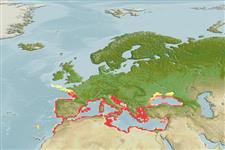>
Eupercaria/misc (Various families in series Eupercaria) >
Sciaenidae (Drums or croakers)
Etymology: Umbrina: Latin, umbra, -ae = shadow, in the sense of phantom; due to its quick movements (Ref. 45335).
More on author: Linnaeus.
Environment: milieu / climate zone / depth range / distribution range
Écologie
marin démersal; profondeur 0 - 100 m (Ref. 3593). Subtropical; 50°N - 30°N, 18°W - 42°E
Eastern Atlantic: Bay of Biscay and Gibraltar to southern Morocco, including the Mediterranean, Black Sea and Sea of Azov. Records south of Morocco have not been supported with descriptions.
Taille / Poids / Âge
Maturity: Lm ? range ? - ? cm
Max length : 104 cm TL mâle / non sexé; (Ref. 128540); common length : 40.0 cm TL mâle / non sexé; (Ref. 3593); poids max. publié: 11.1 kg (Ref. 128540); âge max. reporté: 18 années (Ref. 128540)
Rayons mous dorsaux (Total): 22-23
Found over rocky and sandy bottoms in coastal waters. Juveniles enter estuaries. Feed on bottom invertebrates.
Life cycle and mating behavior
Maturité | Reproduction | Frai | Œufs | Fécondité | Larves
Group synchronous oocytes. A multiple-batch spawner (Ref. 109248).
Chao, L.N. and E. Trewavas, 1990. Sciaenidae. p. 813-826. In J.C. Quero, J.C. Hureau, C. Karrer, A. Post and L. Saldanha (eds.) Check-list of the fishes the eastern tropical Atlantic (CLOFETA). JNICT, Lisbon; SEI, Paris; and UNESCO, Paris. Vol. 2. (Ref. 3593)
Statut dans la liste rouge de l'IUCN (Ref. 130435)
Menace pour l'homme
Harmless
Utilisations par l'homme
Pêcheries: intérêt commercial mineur; Aquaculture: expérimental; pêche sportive: oui
Plus d'informations
RéférencesAquacultureProfil d'aquacultureSouchesGénétiqueElectrophoresesHéritabilitéPathologiesTraitementNutrientsMass conversion
CollaborateursImagesStamps, Coins Misc.SonsCiguateraVitesseType de nageSurface branchialeOtolithesCerveauxVision
Outils
Articles particuliers
Télécharger en XML
Sources Internet
Estimates based on models
Preferred temperature (Ref.
123201): 13.3 - 21, mean 18 °C (based on 276 cells).
Phylogenetic diversity index (Ref.
82804): PD
50 = 0.5000 [Uniqueness, from 0.5 = low to 2.0 = high].
Bayesian length-weight: a=0.00871 (0.00582 - 0.01304), b=3.06 (2.94 - 3.18), in cm total length, based on LWR estimates for this species & Genus-body shape (Ref.
93245).
Niveau trophique (Ref.
69278): 3.4 ±0.46 se; based on food items.
Generation time: 3.9 ( na - na) years. Estimated as median ln(3)/K based on 1
growth studies.
Résilience (Ref.
120179): Milieu, temps minimum de doublement de population : 1,4 à 4,4 années (K=0.28).
Prior r = 0.99, 95% CL = 0.65 - 1.48, Based on 2 stock assessments.
Fishing Vulnerability (Ref.
59153): Moderate vulnerability (43 of 100).
Climate Vulnerability (Ref.
125649): High to very high vulnerability (70 of 100).
Nutrients (Ref.
124155): Calcium = 61.4 [34.6, 122.1] mg/100g; Iron = 0.961 [0.488, 1.669] mg/100g; Protein = 19.6 [18.5, 20.7] %; Omega3 = 0.309 [0.181, 0.482] g/100g; Selenium = 31.9 [17.8, 61.5] μg/100g; VitaminA = 8.8 [3.0, 27.9] μg/100g; Zinc = 0.66 [0.48, 0.95] mg/100g (wet weight);
